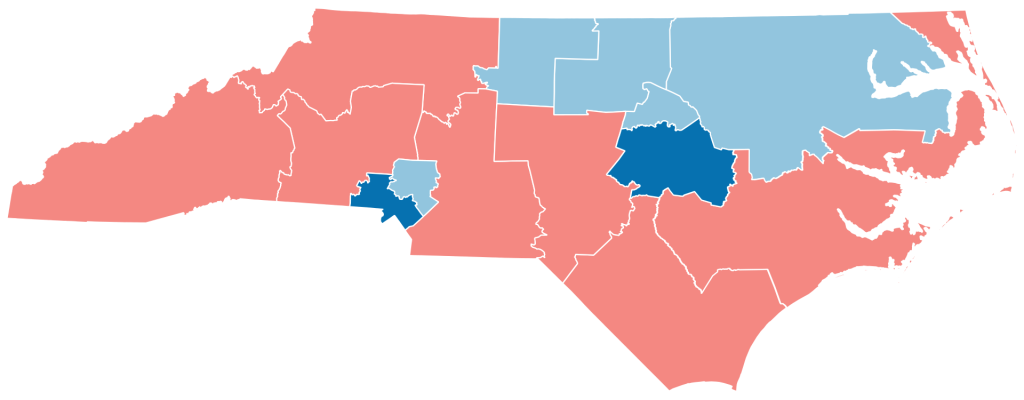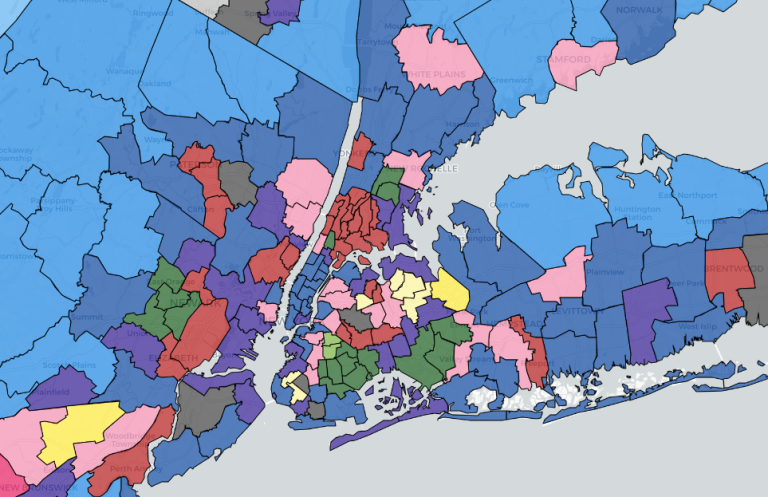
With all of the talk regarding redistricting, starting with Texas, at the behest of President Trump, there has been a mad rush for Democrats to respond to Texas potentially axing 5 Democratic held seats. States like California, New York, and Maryland have all responded by potentially drawing new maps to eliminate as many as 10 Republican held seats. But how feasible is that? Today, we are going to go through each state, and see the viability of redistricting, and potential maps the states could draw.
First, a little vocabulary. Some states have what’s called an independent redistricting commission, which is a nonpartisan committee of people that are tasked with drawing new Congressional maps after each census (when they’re normally supposed to be drawn).
Single District States
All of these states only have one district, meaning that they are impossible to redraw, unless they wanted to take some land and population from Canada or some bigger state.
Delaware and Vermont (1D-0R)
Alaska, North Dakota, South Dakota, and Wyoming (1R-0D)
States with Split Control
All of these states could be opportunities to redistrict for Republicans or Democrats, but their state governments are currently under split control.
Arizona (6R-2D) (1 Vacant): Arizona is very unlikely to redistrict before the 2030 Census, because of a couple of reasons. First, Arizona has a Democratic Governor, and a Republican State House and Senate, and they do not have supermajorities in either chamber. Secondly, Arizona has an independent commission, meaning that they would have to bypass it somehow.
NOTE: AZ-7 was vacated when Raúl Grijalva died in March, it is expected to be a safe Democratic district in the special election in September.
Michigan (7R-6D): Michigan has a Democratic Governor and State House, but a Republican State Senate. Even if Democrats were to flip the State Senate, Michigan also has an independent commission, so it’s pretty unlikely that their maps will be changed until the next Census in 2030.
Minnesota (4D-4R): Minnesota is unique, although currently split, it’s very possible that it won’t be in a matter of months. Minnesota has a DFL (Democrat) governor, and the DFL holds the State Senate. However, Republicans have a one member majority in the State House, with a vacancy. The vacancy was held by Melissa Hortman, who was sadly assassinated in June. If DFL wins her vacated seat, it will be tied, which leads to an awkward power-sharing situation. It’s not impossible, but very unlikely Democrats will be able flip another seat before the deadline to submit maps. If they happened to get into a position where they could pass a new map, they could have a 6D-2R map with all DFL seats being at least D+12 in 2024.
Nevada (3D-1R): Democrats have a majority, but not a supermajority in both chambers of the State Congress, with a Republican Governor. Nevada does not have an independent commission, but it’s basically impossible that Democrats could get a 4D-0R map regardless.
North Carolina (10R-4D): Democrats hold the Governor’s office in North Carolina, while Republicans narrowly lost their supermajority in 2024, but still hold massive majorities. As it stands now, a mid-decade redraw is unlikely to occur before 2030, given the political deadlock in North Carolina: the Governor can veto any attempt at a further Republican gerrymander of the state, and Democrats cannot draw any new maps with them not holding either chamber of the NC General Assembly. One possibility is that Democrats could eventually retake control of the North Carolina Supreme Court, which could strike down the current map as being unfair partisan gerrymandering, which would open up the opportunity for Democrats to gain three to four seats with a more fair, non-partisan map. Another possibility is that Republicans regain a supermajority in both chambers of the state legislature, allowing them to redistrict the state at will, where they could theoretically gain a seat by redrawing NC-1 to lean more Republican.

Pennsylvania (10R-7D): Pennsylvania has a Democratic Governor and controls the State House, but Republicans control the State Senate. If Democrats were to flip the State Senate in 2026, they could theoretically re-draw the maps. Democrats could possibly gain a seat or two in this situation, but as it’s off the cards for 2025-2026, we won’t be covering it.
Virginia (6D-5R): Virginia has a Republican Governor but Democratic majorities in both houses of the State Legislature, as well as an independent redistricting commission. If Democrats were to get a trifecta in 2025 they could repeal/bypass the commission and re-draw, but not before the midterms.
Wisconsin (5R-2D): Wisconsin has a Democratic Governor, but a Republican State House and State Senate. Republicans do not hold a supermajority in either chamber, and the state’s current map is pretty good for Republicans as is, with a 6R-2D map. In theory the liberal-majority state Supreme Court could decide to hear a case against the current map and redraw it during this cycle, but this is a very remote possibility. Democrats could gain a seat or two in this situation, but as it’s likely off the cards for 2025-2026, we won’t be covering it in detail.
Republican Controlled States
All of these states either have a Republican trifecta, or have supermajorities in the Legislature to bypass a Democratic Governor, and thus (mostly) can redraw maps when they want.
Alabama (5R-2D), Georgia (9R-5D), Louisiana (4R-2D), Mississippi (3R-1D), South Carolina (6D-1R) and Tennessee (8R-1D): All of these states, with the exception of Georgia and perhaps South Carolina, have more Democratic representatives than the Republicans controlling the states would like them to have. All of the Democratic districts in these states are majority black, and protected under Section 2 of the VRA (Voting Rights Act). If the VRA were to get struck down by the Supreme Court however, chances are that these states would try to create new, more favorable maps as fast as possible. It isn’t super likely, so it won’t be covered in detail, but Republicans could get between 5-7 seats in the scenario the VRA is struck down.
Florida (20R-8D): Under the rule of their supreme leader Ron DeSantis, Florida and its Republican supermajority are ready and willing to redraw the maps mid-decade at the behest of Donald Trump, and the legislature is not bound by any independent redistricting committee. Florida passed “fair district amendments” in 2010, but DeSantis has made it clear he believes those amendments are unconstitutional, and last month, Florida’s Supreme Court sided with him after he eliminated a majority-minority district following the 2020 census, which makes it likely that the courts will side with him again if legal issues arise. There are rumors that a new map will target four Democratic seats: FL-9, FL-14, FL-25, and FL-23. An example of a 24R-4D map that Florida could draw, from DRA user RealTXPolitics, would eliminate Darren Soto’s Orlando seat, make Kathy Castor’s seat into an seat Trump won by 6, and get rid of 2 Democratic held seats in South Florida.

Indiana (7R-2D): A state that has been thrown around as a big opportunity for Republicans is Indiana. There is no independent commission, and Republicans hold a trifecta in the state’s government. The delegation is currently 7 Republicans, and 2 Democrats, with Democrat Frank Mrvan’s seat being fairly competitive. Indiana could easily eliminate his seat, and keep all Republican districts safely red. There have even been some rumors to try to also eliminate Andre Carson’s Indianapolis seat, and make it a clean 9R-0D sweep. However, this could easily backfire on Republicans, as there would be multiple new seats Democrats could theoretically win. Here is an example of an 8R-1D map, with all Republican districts being at least +18 R in 2024.
Kansas (3R-1D) & Kentucky (5R-1D): Kansas and Kentucky both have Democratic Governors, but Republicans have supermajorities in both chambers of the State Congress. Kansas could look to make KS-3 (Sharice Davids) more competitive, but as she won it by 11 in 2024, it may be risky in a favorable year for Democrats. An example could be one like this, where KS-2 takes some of Kansas City, turning KS-3 into a toss-up district.
Kentucky could also look to get rid of KY-3 (Morgan McGarvey), but again, as he won it by 23 points in 2024, that may be risky. However, as Kentucky has more districts, and is more Republican, it’s possible to crack that district to get a 6R-0D delegation.
Missouri (6R-2D): Other than Texas, Missouri is the Republican state most talked about potentially redistricting mid-decade. Trump and Republican leaders want to eliminate MO-5, a Kansas City district held by Democrat Emanuel Cleaver. There’s nothing really stopping them from doing this, as Republicans have a trifecta in Missouri, and there’s no independent redistricting commission. A potential scenario may look like this, with a 7R-1D map, with all Republican districts won by Trump by at least 11 points in 2024.
New Hampshire (2D-0R): New Hampshire is probably the most interesting state in this category, as while the congressional delegation is fully Democratic, Republicans hold the Governor’s Mansion, and have majorities in both houses of the State Legislature. In 2022, Republicans attempted to redraw the map to make NH-1 more republican, but then-governor Chris Sununu vetoed the map; causing the courts to step in and appoint a “special master” to redraw the map, which restored NH-1’s Democratic lean. Theoretically, Republicans could ATTEMPT to gain a seat in New Hampshire if Governor Kelly Ayotte is willing to sign into law the proposed 2022 map (assuming it is reintroduced), but that is unlikely given Ayotte’s past apprehensiveness toward gerrymandering. However, even the most gerrymandered New Hampshire map we could make would have one of the districts only be at Trump +3 in 2024, which makes it far from a sure thing.

Ohio (10R-5D): Republicans in Ohio hold the Governorship; have a supermajority in the senate; and narrowly lost their supermajority in the House in 2024. Redistricting is on the docket for Ohio in 2025, however it is hard to say how many seats Republicans will get out of it, in part due to their unique redistricting process. In Ohio, it is first up to the general assembly to come up with maps, which requires both chambers to reach a three-fifths agreement on a bipartisan map; if an agreement is not achieved, the Ohio Redistricting Commission is activated to take over the process. The commission is given a month to agree to a bipartisan map, and if that falls through, the redistricting effort returns to the legislature. If a bipartisan map is agreed upon, that map lasts 10 years, but if the commission doesn’t have bipartisan agreement, or if the legislature passes a map by a simple majority vote on the second go around, the map only lasts for four years. Republicans hold five of seven seats on the redistricting commission, while they have six of seven seats on the supreme court, making it likely the eventual map will skew Republican. Republicans are hoping to redraw two Democratic seats (OH-9, and OH-13) in their favor, with a third (OH-1) also floated. Overall, Republicans could gain upward to three seats if the redistricting process goes their way.

Texas (25R-13D): With both houses of the Texas Legislature firmly Republican, along with a Republican governor, and no independent redistricting committee, Texas is able to redistrict at will (which they are attempting to do right now!); however, the new map will face challenges. Republicans are seeking to flip five districts, three of which are to be gained by cracking the cities and diluting their vote share, while the other two are counting on Republican gains among Latino voters in the RGV to remain or grow larger. As of 8/6/25, Democratic officials in the State House have left Texas, in order to delay a vote as long as possible on the new maps. Republicans are trying, and threatening to make them come back, but as of now they have not. While this map may not backfire upon Republicans, it does have a chance to be less effective then they hope, as Hispanics may shift back to 2020 levels of support for Democrats.
Arkansas (4R-0D), Idaho (2R-0D), Iowa (4R-0D), Montana (2R-0D), Nebraska (3R-0D), Oklahoma (5R-0D), Utah (4R-0D), and West Virginia (2R-0D): All of these states are Republican controlled, and have only Republican delegations in Congress, so it’s unlikely they will move to redistrict before the 2030 Census. The only exception may be Nebraska. Don Bacon, who represents NE-2, is retiring, and his district voted for Biden by 6% and Harris by 4%. It’s pretty likely a Democrat will win that seat under the current map, so Nebraska could move to make it more Republican. Idaho and Montana also have independent redistricting commissions.
Democratic Controlled States
All of these states have Democratic Trifectas, and thus can pass new maps without opposition*. Of course, if you notice the asterisk, it isn’t so simple. A lot of big Democratic states where Dems can draw more favorable maps have independent commissions. Democrats have been more interested in fair maps than Republicans, and it’s a roadblock towards making more favorable delegations.
California (43D-9R): California has a Democratic governor and Democratic supermajorities in both houses of the state legislature. California also has an independent redistricting commission. Democrats could gain any number of seats (up to all nine) depending on how aggressively they gerrymander. The most plausible gerrymander is a Democratic pickup of five to six seats. However, California must first pass a proposition to nullify their independent redistricting commission, which would need to be voted on by November of 2025 for the new map to be eligible for the midterms. Here’s how a California map might look like, with a 48D-4R map in 2024 by DRA user ammeraz.
Colorado (4D-4R): Colorado has a Democratic Governor and majorities, but not supermajorities, in both chambers of the General Assembly. Colorado also has an independent redistricting commission. Democrats can not put a proposition to nullify the commission on the ballot via legislative action due to their lack of supermajorities. While it would be possible to do it via a signature campaign instead, the 2025 deadline for this has already passed. Additionally, Governor Polis has shown little appetite for combativeness in the vein of Pritzker or Newsom and the state party is a bit of a mess right now, making it unlikely even in future years. Democrats could pick up three to four seats if they redrew, but as it’s not possible for 2025-2026, I won’t be covering it in detail.
Illinois (14D-3R): Illinois has a Democratic Governor and Democratic majorities in both chambers of the State Legislature. Illinois does not have an independent redistricting commission, and can redistrict at the will of the legislature. However, Illinois is already pretty gerrymandered, so at most, they can pick up an additional seat. A potential map would be one from DRA user copelovitchmicah, which makes the gerrymander even more gross, and eliminates one of the three Republican rural seats. As you can see though, this might be risky, as a few of those seats are not exactly safe.
Maryland (7D-1R): Maryland has a Democratic governor and Democratic supermajorities in both chambers of the state legislature. Maryland does not have an independent redistricting commission, and can redistrict at the will of the legislature. However, the state Supreme Court has a conservative majority that struck down an 8-0 map in 2021, which Dems would need to find a way around, by packing the Supreme Court. Democrats could gain one seat if they drew new maps in their favor. A good example would be by DRA User pittsburgh_mapper, which makes Andy Harris’s seat (MD-1) a D+10 seat, shores up April McClain Delaney (MD-6) into a safe Dem seat, and keeps two majority black districts.
New Jersey (9D-3R): New Jersey has a Democratic Governor and majorities, but not supermajorities, in both houses of the state legislature. New Jersey has an independent redistricting commission, and Democrats can not put a proposition up to nullify the commission due to their lack of a supermajority in both houses. Control of the General Assembly is also up in 2025, so depending on how Democrats do (and if New Jersey continues shifting Republican or not) this could further limit their ability to redistrict before 2030. Democrats could pick up one to two seats if they redrew, but as it’s not possible for 2025-2026, we won’t be covering it in detail.
New York (19D-7R): New York has a Democratic Governor and Democratic majorities in both chambers of the State Legislature. It’s pretty unlikely however, that Democrats will be able to redraw maps before the midterms. There is an independent commission, which Democrats would have to bypass using a constitutional amendment. However, according to the Hill, “any amendment to the state constitution requires it to be passed in two consecutive sessions before going before voters”, which would be impossible to happen before the deadline for new maps. However, if Democrats were able to get maps redrawn, they could potentially gain three to four seats, as seen in this map by DRA user avatarthe54.
Oregon (5D-1R): Oregon has a Democratic Governor and Democratic majorities in both chambers of the Legislative Assembly. Oregon does not have an independent redistricting commission, and can redistrict at the will of the Legislative Assembly. Democrats could gain one seat if they drew new maps in their favor. Here is what a 6D-0R Oregon may look like, with all seats at least D+9 in the 2024 election.
Washington (8D-2R): Washington has a Democratic Governor and majorities, but not supermajorities, in both houses of the state legislature. Washington also has an independent redistricting commission. Democrats can not put a proposition to nullify the commission on the ballot due to their lack of supermajorities. Democrats could pick up one to two seats if they redrew, but as it’s not possible for 2025-2026, we won’t be covering it in detail.
Connecticut (5D-0R), Hawaii (2D-0R), Maine (2D-0R), Massachusetts (8D-0R), New Mexico (3D-0R), and Rhode Island (2D-0R): All of these states are controlled by Democrats, but also only have Democrats representing them in Congress, so there’s not much of a point to consider redistricting before the 2030 census, with the exception of Maine. ME-2 is held by Jared Golden, a Democrat, despite the district voting for Trump by 9. It’s possible they could consider making his district more Democratic, but again, as he holds it currently, we don’t think they will consider going for it.
Thoughts on Gerrymandering
Gerrymandering is a horrible plague on the United States, and all politicians should work towards banning it as quickly as possible. We don’t think that will happen, as Republicans have repeatedly voted against bills such as this in Congress, like the For the People Act, and generally have gone further in gerrymandering than Democrats. Maybe one day it will be fixed, but that is unlikely as long as we are in the current political climate we are in.
Written by Danny Cowan, as well as ElectionCord Discord members Ceartin and Skiman.
NOTE: Any maps not specifically cited were made by Danny Cowan via Redistricter.
Links/Resources:
California: https://davesredistricting.org/join/158f54f0-588d-42a0-8fb1-71b2391f5f98
Florida: https://davesredistricting.org/join/7160a530-770d-464c-b39d-89dbad86c049
Maryland: https://davesredistricting.org/join/2553fc6c-00e1-487d-b772-b9ea154f0c1a
Illinois: https://davesredistricting.org/join/6798244d-ec79-49e1-b5f0-791d0873302f
New York: https://davesredistricting.org/join/c2cc1450-012e-4682-ae3b-33ae09374c23
The Hill: https://thehill.com/homenews/5435101-new-york-redistricting-texas-hochul/
Ohio: https://davesredistricting.org/join/032fc10f-acc6-43f9-8835-8910e194812f
https://thehill.com/homenews/campaign/5432996-florida-republicans-redrawing-congressional-lines



